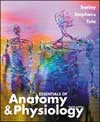 |  Essentials of Anatomy & Physiology, 4/e Rod R. Seeley,
Idaho State University
Philip Tate,
Phoenix College
Trent D. Stephens,
Idaho State University
The Lymphatic System and Immunity
Study OutlineFunctions of the Lymphatic System Clinical Focus: Disorders of the Lymphatic
SystemFluid balance p. 378
Fat absorption
Defense
Lymphatic System
Lymphatic Vessels(Fig. 14.1, p. 375)Lymphatic capillaries and lymph formation(Fig. 14.2, p. 375)Right lymphatic duct(Fig. 14.3, p. 376)Thoracic duct
Lymphatic organs
Tonsils(Fig. 14.4, p. 376)Palatine tonsils
Pharyngeal tonsils
Lingual tonsils
Lymph nodes(Fig. 14.5, p. 377)Spleen(Fig. 14.6, p. 377)Thymus(Fig. 14.1, p. 375) Immunity
Innate immunity
Adaptive immunity
Specificity
Memory
Innate Immunity
Mechanical mechanisms
Skin and mucous membranes
Tears, saliva, and urine
Chemical mediators
Lysozyme
Histamine, prostaglandins, leukotrienes
Complement
Interferons
Cells
Phagocytic cells
Neutrophils
Macrophages
Cells of inflammation
Basophils
Mast cells
Eosinophils
Natural killer cells
Inflammatory response(Fig. 14.7, p. 380)Effects
Vasodilation
Attraction of phagocytes
Increased vascular permeability
Fibrinogen and complement involvement
Local inflammation
Systemic inflammation
Adaptive Immunity(Table 14.1, p. 382)Cell recognition-antigens
Foreign antigens
Self antigens
Autoimmune disease
Origin and development of lymphocytes(Fig. 14.8, p. 382-83)T cells
B cells
Activation and multiplication of lymphocytes
Antigen recognition
Processing of antigen
Presenting antigen and co-stimulation with MHC
Lymphocyte proliferation - helper T-cells(Fig. 14.9, p. 384) Antibody-mediated immunity (B cells)(Fig. 14.10, p. 385)Antibodies(Table 14.2, p. 386)Structure(Fig. 14.11, p. 386)Effects(Fig. 14.12, p. 387)Production(Fig. 14.13, p. 388) Primary response
Secondary response
Plasma cells
B memory cells
Cell-mediated immunity (T cells)(Fig. 14.14, p. 389)Cytotoxic T cells
Cytokines (lymphokines)Cell lysis
T memory cells
Immune interactions(Fig. 14.15, p. 390)
Clinical Focus: Immune system Problems of Clinical Significancep.
392-93
Immunotherapy
Vaccinations
Monoclonal antibodies
Acquired Immunity(Fig. 14.16, p. 391)Active natural immunity
Active artificial immunity-vaccination
Passive natural immunity
Passive artificial immunity-antiserum
Systems Pathology - systemic lupus erythematosusSystems Interaction Table p.
395
|
|



 2002 McGraw-Hill Higher Education
2002 McGraw-Hill Higher Education